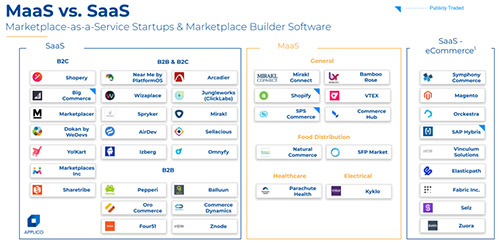Business customers are starting to demand full marketplace e-commerce offerings from distributors. Distributors’ best customers want to get everything from one place – and who can blame them? But this means that distributors are left scrambling to figure out how they can quickly deliver on at least part of the marketplace value proposition.
Many distributors have already invested millions in their e-commerce infrastructure and don’t want to start all over again. Instead, they are looking for an endless aisle offering that allows them to add additional products from third-party sellers. This endless aisle capability is what many call a “marketplace” business model. There are two pieces to the marketplace puzzle: the technology and attracting third-party sellers.
The latter, the network of third-party sellers, is the hard part and where the value lies over the long-term. As platform strategy 101 tells us: the technology is a commodity. The power is in the network.
As a result, we are seeing two types of marketplace technology providers: SaaS (software as a service) and, more recently, MaaS (marketplace as a service). And there are significant differences and tradeoffs between the two.
Both providers offer technology tools to give your e-commerce site an endless aisle capability, but that’s about where the similarities end.
What is a marketplace? Product or business model?
A key question for every distributor to answer for itself on its marketplace journey is this: Do you view marketplace as a product feature or a business model? The former approach means creating an incremental add-on to your existing product offerings. The latter approach requires a significant, strategic initiative that you need to control in a material way. There are pros and cons to either approach. But once you know the answer to this question, it becomes much more straightforward to determine SaaS vs. MaaS.
Endless-aisle offerings, also known as a headless commerce product, allow for a distributor to sell products that are not taken on its balance sheet. Sometimes, these products are also drop-shipped directly to the customer, never touching the distributor’s warehouse. Amazon Business has hundreds of thousands of third-party sellers and Amazon’s consumer facing site has millions. As Jeff Bezos has said numerous times, the key differentiator for Amazon is its third-party sales. In 2019, 56% of Amazon’s GMV was from third-party sellers and this share has only increased since. In Bezos’s words, third-party sellers are “kicking our butts.”
MaaS vs. SaaS – how important are third-party sellers?
The biggest difference between MaaS and SaaS offerings is ownership of the third-party sellers. These sellers are expensive to attract and even harder to retain. You need to woo the sellers with the promise of e-commerce sales, give them easy tools to match and upload their product catalog, set pricing and inventory levels, and much more. Both SaaS and MaaS provide a lot of these technology offerings – but, who, at the end of the day, owns the data and owns the relationship with the third-party seller?
- In a SaaS offering, the distributor owns the third-party seller relationship and all the data.
- In a MaaS offering, the MaaS provider owns the third-party seller relationship and earns money off any sales through the third-party seller.
MaaS solutions are usually a better fit for a distributor that views marketplace as a product, not a business model. MaaS should generally be cheaper on their up-front setup and faster to get to market. The MaaS provider makes its revenue on the backend. As you sell more third-party products from the MaaS’s endless aisle offering, the provider takes a cut of the margin. The MaaS provider can justify this take rate because it is bringing you its own third-party sellers. There’s a high cost to acquire third-party sellers, upload their product catalog, manage their inventory levels and ensure timely deliveries. For all this effort, the MaaS offering reduces some of that pain for the distributor, and, in exchange, takes a cut of the transaction on the third-party sales it facilitates.
For SaaS solutions, you typically pay a subscription fee and receive a software tool that lets you attract third-party sellers to sign up and manage the process of selling their products on your e-commerce site. If you answered that a marketplace strategy is key to your distributor’s long-term success, you most likely want to choose a SaaS offering to get started. The reason is that you want the third-party sellers to be unique to your e-commerce site. The SaaS tool is just a piece of technology. You still have to go through all the effort to acquire third-party sellers, manage them, incentivize them and keep them happy. That’s a lot of work – expensive work. And, if you are spending all these resources to attract third-party sellers, you want to stay far away from MaaS.
MaaS and SaaS = oil and water
MaaS and SaaS are like oil and water. Amazon and Google. Alibaba and Baidu. The US and China have more in common than MaaS and SaaS. They are two different business models with conflicting priorities. Given the inherent conflict in the two models, most technology providers choose to offer one or the other, not both business models – as you’ll see in the landscape below. You can also find more detailed analysis of the providers in each category in our MaaS vs. SaaS Provider report.

SaaS offerings should enable distributors to be successful in creating their own marketplaces, with thousands (or more) of unique third-party sellers. MaaS providers want all distributors and e-e-commerce startups to be on the same playing field – all of them integrating into the MaaS provider’s network of third-party sellers – one common endless aisle offering.
Marketplace business and MaaS co-operation
The long-term goal of MaaS is to commoditize the supply side network effect and reduce the unique, competitive advantage of owning your own marketplace. In short, a MaaS provider is a long-term competitor to any distributor trying to build a dominant marketplace business. If you are a marketplace business and considering leveraging a MaaS provider, tread very carefully and don’t forget that the MaaS provider would ultimately like your unique sellers to also be a seller on its MaaS network!
Alex Moazed is the founder and CEO of Applico. He founded Applico in 2009 when he was 20 years old and funded the company with his own credit cards. Alex co-authored the best-selling book, Modern Monopolies, which defines the platform business model dominating the 21st century economy. In his role as CEO, he works directly with Fortune 500 C-suites and boards to help them build or buy their own platform businesses.
Nicholas Johnson is principal at Applico, where he works directly with Fortune 500 C-Suites and Boards to help them build and buy their own platform businesses. He also oversees the company’s research into platforms, including the launch of a forthcoming platform business ETF. He is the co-author of Applico’s Amazon-best seller Modern Monopolies. Prior to joining Applico, he spent several years as an editor at the Institute for New Economic Thinking.
Related Posts
-
Three of MDM’s five most-read blogs published last month focused on e-commerce and digital, while…
-
It all starts with your website — but it doesn't end there. B2B online marketing…
-
Here are the Top 10 (plus one) digital commerce enhancements you can make to successfully…






